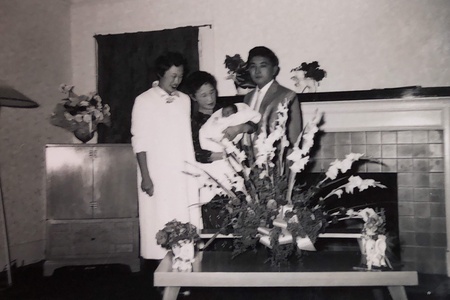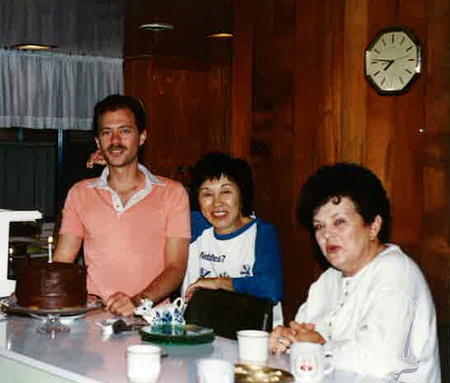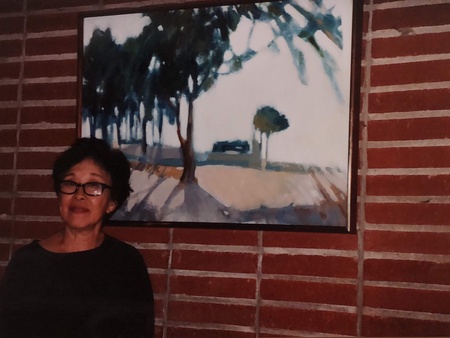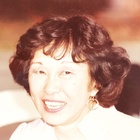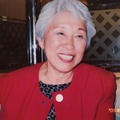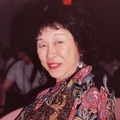Yamauchi’s elder sister Yukiko described to me the announcement that blared over the loudspeakers throughout the camp on August 14, 1945: “The war is over. You can all go home now.” She recalled thinking at that moment: '…but we have no home.’1
With the camp closing down and their patriarch cremated, the Nakamuras caught one of the last trains out of Poston, which left from nearby Parker, Arizona, with Yamauchi’s mother clutching a container with her husband’s (she claimed) still-warm ashes. The family went to San Diego where they lived for a time in a government-owned trailer.
Yamauchi and Yukiko, searching desperately for work, saw a “help wanted” sign at a factory that developed and printed photographs. Neither of them had any related experience, but after deciding they had nothing to lose, they knocked at the factory door and begged the manager to hire them, which, to their surprise and extreme relief, he did.
Yukiko became a skilled printer while Yamauchi spent a year working in the darkroom until, joining that unit’s strike for higher pay, she and her co-workers were all fired. She left San Diego to join her friend Si in Los Angeles. Si was writing for an African American weekly, the Los Angeles Tribune, while Yamauchi spent nights attending the Otis Art Institute (now Otis College of Art and Design), at the time in its original location on Wilshire Boulevard adjacent to MacArthur Park, where she was the only Japanese American in many of her classes.
Yukiko, meanwhile, had taken on the principal responsibility for caring for their mother, whose health, broken by hardship, disappointment and the dislocation of the war, was rapidly failing; she outlived her husband by only a few years. When, more than three decades later, Yamauchi had the opportunity to visit Japan herself for the first time, she wrote this to me upon her return:
“There were times, as when I saw the beautiful Mount Fuji (no picture or postcard can capture the magnificence, the grace) or ate those crisp, juicy apples, that I remembered my mother. My throat grew tight then…should life be so unfair that I am the one to come to Japan in my dead mother’s place, her Japan, to taste the fruit she hungered for, to see the landscape she yearned to return to, and to clasp her sister’s2 hand?”
Chester Yamauchi of Berkeley, California, was a “no-no” boy who had befriended Yamauchi’s brother. The no-no’s were those who responded negatively to the last two questions on the “Statement of United States Citizen of Japanese Ancestry,” the infamous 1943 “loyalty oath” that all interned Nisei were required to fill out in exchange for their freedom. It consisted of 28 prying questions (concerning such topics as education, employment, finances, hobbies, religion, languages, travel and even newspaper and magazine subscriptions), but is most remembered for the last two. Number 27—"Are you willing to serve in the armed forces of the United States on combat duty, wherever ordered?”—had to be answered, presumably “yes,” by all… man, woman or child, no matter their age.
Number 28 should have been number 22, as in Catch 22: “Will you swear unqualified allegiance to the United States of America and faithfully defend the United States from any or all attack by foreign or domestic forces, and forswear any form of allegiance or obedience to the Japanese emperor, or any other foreign government, power, or organization?” By combining these two unrelated questions into one, the respondent was forced to admit, if answering “yes,” that they had been loyal to the emperor, and if answering “no,” that they were not loyal to the United States.
Chester and Yamauchi’s brother, refusing to be turned into “cannon fodder” on behalf of the government that had betrayed them, were among those sent to the Tule Lake Segregation Center in the far reaches of northern California, about 10 miles south of the Oregon border. Yamauchi later said she didn’t realize how strongly her brother believed in his principles. She herself, itching for liberty, answered “yes yes,” and was able to leave the camp.
Once the Japanese surrendered, the no-no’s were presumably no longer a threat to the security of the United States. Only 428 Tule Lake internees were repatriated to Japan (plus 1,072 more from Fort Lincoln in North Dakota); the rest were unceremoniously returned to the society they had allegedly endangered. Chester and Wakako met and fell in love, and were married in 1948, first privately in Las Vegas, then with all the trimmings in Los Angeles. At their home in Mid-City L.A., Yamauchi took on day jobs—factory work (pants, stationery), fulfilling department store orders, hand-painting flowers and flamingos on shower curtains—to help put Chester through school at UCLA.
Chester Yamauchi eventually became a well-known caterer for the local Nisei community, handling banquets, weddings and other celebrations. In 1955, the couple gave birth to a daughter, Joy, their only child.
Although ever the dutiful homemaker, Yamauchi felt unfulfilled. She had always been an avid reader, beginning with 20 volumes of the Book of Knowledge (“My father could not resist a traveling salesman…”), and moving on to Henry Wadsworth Longfellow, Zane Grey and Thomas Wolfe (whom she credited with teaching her to embrace the full range of her emotions). Now she was immersed in the work of some of the most creative outcasts of the 1950s: gay men like Truman Capote, James Baldwin and Tennessee Williams.
Her friend Si, meanwhile, who was already a well-known author among Japanese Americans, suddenly stopped writing due to familial and other obligations. Despite much insecurity, Yamauchi felt compelled to take over the reins until Si was ready to return to her vocation. And there was another reason she started to write again:
“Years ago, when my mother passed away, she left a diary in Japanese that I was unable to read. I realized I never really knew her nor would I ever now know her, and it became important to me to leave something of myself that my daughter could read and perceive the person I really was, so she could know who she was and why.”3
Just as fate had seemed to promote the close tie between Yamauchi and her mentor Si, now it stepped in to help Yamauchi publish some of her work. She was writing short stories when, in 1959, Henry Mori, the editor of the Japanese-English daily, the Los Angeles Rafu Shimpo, who was familiar with Yamauchi’s artwork in the Poston Chronicle, asked her to do some illustrations to dress up the paper’s annual Christmas-New Year’s issue. Yamauchi’s business-savvy husband suggested she make a deal: she would draw for Mori if he would publish her stories. He agreed, and from 1960 to 1974, Rafu Shimpo printed a story or essay of Yamauchi’s every year.
Yamauchi’s creativity continued to express itself through art as well as words. She joined the Beverly Hills Art League and took painting classes run by the group at the city’s high school. It was there that she first met my mother, Florence Levine, who lived in Culver City, and with whom Yamauchi became lifelong friends (which is how I came to know her). They studied with the Turkish-born Armenian artist Kero Antoyan, who taught Yamauchi a lesson she never forgot.
At one of the first classes she attended, she finished a painting, then leaned it against the wall for Antoyan to comment on. Looking at it, he said in his thick accent, “This is a fine painting, except for one thing: it has no soul.” Yamauchi often alluded to this pithy critique, freely confessing that Antoyan had been right—that he had seen through her attempt to get by on technique alone.
From then on, she was steadfast in her assertion that all creative work be rooted in the artist’s own personal, emotional truth. A number of Yamauchi’s paintings hung on the walls of her home in Gardena (which she and Chester had purchased in 1965), including one evocatively stark landscape, painted in her typical near-abstract style with its blended, muted colors, that featured a tiny figure dwarfed by a towering eucalyptus tree. She was, she said, painting what she knew—that having grown up in the California desert, such scenes were embedded in her memory, and represented the small piece of the world she found most familiar.
Notes:
1. Yukiko was two months away from completing her degree at Oceanside Carlsbad Junior College (now MiraCosta College) when the internment took place. The dean of students, sympathetic to her plight, told her to get her remaining assignments from her professors and mail them in from camp. She received her degree, ranking 2nd in her class, and in 2010, was given an honorary degree as well, thanks to a state law enacted the year prior that required all California colleges to award degrees to Nisei students whose studies were disrupted by the internment.
2. Yamauchi’s aunt, who was 83 at the time (1983).
3. As quoted in Aiiieeeee! An Anthology of Asian-American Writers, edited by Frank Chin, Jeffery Paul Chan, Lawson Fusao Inada and Shawn Hsu Wong, Howard University Press, Washington, D.C., 1974, p. 192
© 2019 Ross Levine



